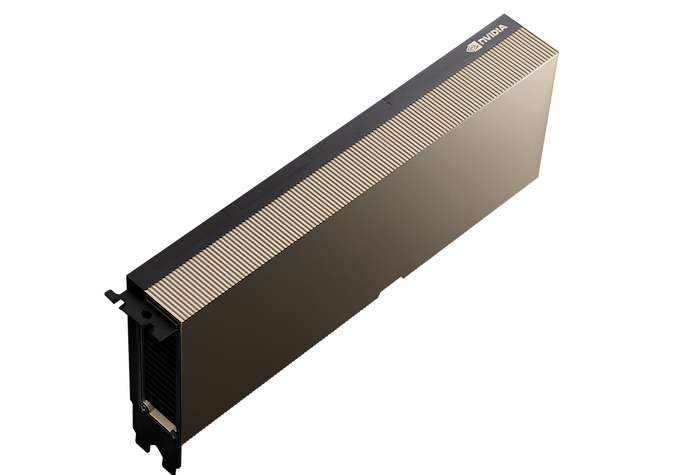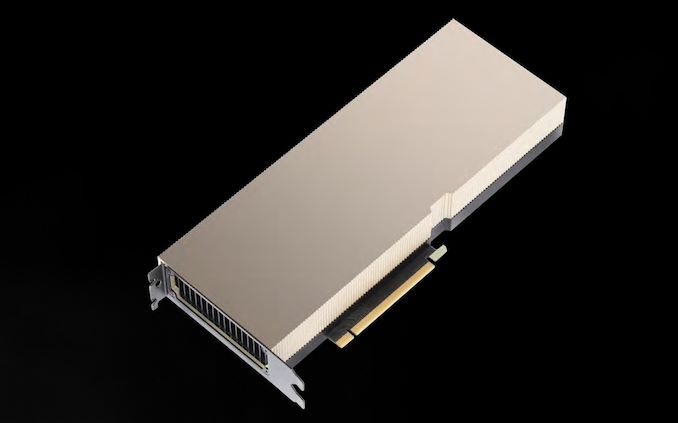NVIDIA Announces PCIe A100 Accelerator: 250 Watt Ampere In A Standard Form Factor
by Ryan Smith on June 22, 2020 3:30 AM EST
With the launch of their Ampere architecture and new A100 accelerator barely a month behind them, NVIDIA this morning is announcing the PCIe version of their accelerator as part of the start of the now-virtual ISC Digital conference for high performance computing. The more straight-laced counterpart to NVIDIA’s flagship SXM4 version of the A100 accelerator, the PCie version of the A100 is designed to offer A100 in a more traditional form factor for customers who need something that they can plug into standardized servers. Overall the PCIe A100 offers the same peak performance as the SXM4 A100, however with a lower 250 Watt TDP, real-world performance won’t be quite as high.
The obligatory counterpart to NVIDIA’s SXM form factor accelerators, NVIDIA’s PCIe accelerators serve to flesh out the other side of NVIDIA’s accelerator lineup. While NVIDIA would gladly sell everyone SXM-based accelerators – which would include the pricey NVIDIA HGX carrier board – there are still numerous customers who need to be able to use GPU accelerators in standard, PCIe-based rackmount servers. Or for smaller workloads, customers don’t need the kind of 4-way and higher scalability offered by SXM-form factor accelerators. So with their PCIe cards, NVIDIA can serve the rest of the accelerator market that their SXM products can’t reach.
The PCIe A100, in turn, is a full-fledged A100, just in a different form factor and with a more appropriate TDP. In terms of peak performance, the PCIe A100 is just as fast as its SXM4 counterpart; NVIDIA this time isn’t shipping this as a cut-down configuration with lower clockspeeds or fewer functional blocks than the flagship SXM4 version. As a result the PCIe card brings everything A100 offers to the table, with the same heavy focus on tensor operations, including the new higher precision TF32 and FP64 formats, as well as even faster integer inference.
| NVIDIA Accelerator Specification Comparison | ||||||
| A100 (PCIe) |
A100 (SXM4) |
V100 (PCIe) |
P100 (PCIe) |
|||
| FP32 CUDA Cores | 6912 | 6912 | 5120 | 3584 | ||
| Boost Clock | 1.41GHz | 1.41GHz | 1.38GHz | 1.3GHz | ||
| Memory Clock | 2.43Gbps HBM2 | 2.43Gbps HBM2 | 1.75Gbps HBM2 | 1.4Gbps HBM2 | ||
| Memory Bus Width | 5120-bit | 5120-bit | 4096-bit | 4096-bit | ||
| Memory Bandwidth | 1.6TB/sec (1555GB/sec) |
1.6TB/sec (1555GB/sec) |
900GB/sec | 720GB/sec | ||
| VRAM | 40GB | 40GB | 16GB/32GB | 16GB | ||
| Single Precision | 19.5 TFLOPs | 19.5 TFLOPs | 14.1 TFLOPs | 9.3 TFLOPs | ||
| Double Precision | 9.7 TFLOPs (1/2 FP32 rate) |
9.7 TFLOPs (1/2 FP32 rate) |
7 TFLOPs (1/2 FP32 rate) |
4.7 TFLOPs (1/2 FP32 rate) |
||
| INT8 Tensor | 624 TOPs | 624 TOPs | N/A | N/A | ||
| FP16 Tensor | 312 TFLOPs | 312 TFLOPs | 112 TFLOPs | N/A | ||
| TF32 Tensor | 156 TFLOPs | 156 TFLOPs | N/A | N/A | ||
| Relative Performance (SXM Version) | 90% | 100% | N/A | N/A | ||
| Interconnect | NVLink 3 12 Links (600GB/sec) |
NVLink 3 12 Links (600GB/sec) |
NVLink 2 4 Links (200GB/sec) |
NVLink 1 4 Links (160GB/sec) |
||
| GPU | GA100 (826mm2) |
GA100 (826mm2) |
GV100 (815mm2) |
GP100 (610mm2) |
||
| Transistor Count | 54.2B | 54.2B | 21.1B | 15.3B | ||
| TDP | 250W | 400W | 250W | 300W | ||
| Manufacturing Process | TSMC 7N | TSMC 7N | TSMC 12nm FFN | TSMC 16nm FinFET | ||
| Interface | PCIe 4.0 | SXM4 | PCIe 3.0 | SXM | ||
| Architecture | Ampere | Ampere | Volta | Pascal | ||
But because the dual-slot add-in card form factor is designed for lower TDP products, offering less room for cooling and typically less access to power as well, the PCIe version of the A100 does have to ratchet down its TDP from 400W to 250W. That’s a sizable 38% reduction in power consumption, and as a result the PCIe A100 isn’t going to be able to match the sustained performance figures of its SXM4 counterpart – that’s the advantage of going with a form factor with higher power and cooling budgets. All told, the PCIe version of the A100 should deliver about 90% of the performance of the SXM4 version on single-GPU workloads, which for such a big drop in TDP, is not a bad trade-off.
And on this note, I should give NVIDIA credit where credit is due: unlike the PCIe version of the V100 accelerator, NVIDIA is doing a much better job of documenting these performance differences. This time around NVIDIA is explicitly noting the 90% figure in their their specification sheets and related marketing materials. So there should be a lot less confusion about how the PCIe version of the accelerator compares to the SXM version.
Other than the form factor and TDP changes, the only other notable deviation for the PCIe A100 from the SXM version is how NVLink connections work. For their PCIe card NVIDIA is once again using NVLink bridges connected across the top of A100 cards, allowing for two (and only two) cards to be linked together. The upshot is that with 3 NVLink connectors, all 12 of the GA100's GPU physical links are being exposed, meaning that the card has full access to its NVLink bandwidth. So although you can only talk to one other PCIe A100 card, you can do so at a speedy 300GB/sec in each direction, 3x the rate a pair of V100 PCIe cards communicated at.
Otherwise the PCIe A100 comes with the usual trimmings of the form factor. The card is entirely passively cooled, designed to be used with servers with powerful chassis fans. And though not pictured in NVIDIA’s official shots, there are sockets for PCIe power connectors. Meanwhile, with the reduced usage of NVLink in this version of the card, A100’s native PCIe 4 support will undoubtedly be of increased importance here, underscoring the advantage that an AMD Epyc + NVIDIA A100 pairing has right now since AMD is the only x86 server vendor with PCIe 4 support.
Wrapping things up, while NVIDIA isn’t announcing specific pricing or availability information today, the new PCIe A100 cards should be shipping soon. The wider compatibility of the PCIe card has helped NVIDIA to line up over 50 server wins at this point, with 30 of those servers set to ship this summer.
Source: NVIDIA











29 Comments
View All Comments
mode_13h - Monday, June 22, 2020 - link
I hope they release a Titan A version.Kjella - Monday, June 22, 2020 - link
Well the last Titan was a gamer card w/HBM2 instead. Now the rumor is that it'll essentially just be a fully unlocked card with 24GB of consumer RAM (GDDR6x). Which I'd be totally fine with, at least then you could run some of the bigger deep learning models without cashing out $2500. When AMD can sell 8GB of RAM on the RX 570 for less than $200 then you know 24GB worth of RAM shouldn't cost that much. They just lack competition.CiccioB - Monday, June 22, 2020 - link
AMD lose money on the 480/470, so why should you expect a healthy company like Nvidia to do the same?ragenalien - Monday, June 22, 2020 - link
Source? Because I really doubt that. They also sell the RX 5500 xt with 8GB and I highly doubt they would lose money on three generations of mid range cards.CiccioB - Tuesday, June 23, 2020 - link
Source? AMD quarters results.See the gain of the GPU+CPU division. They are so low for a reason. And it is certainly not due to CPU over selling.
GPU division has been in red much before AMD hid the revenue under the same CPU invoice in the reports. And now, after years of combiner red, the GPU+CPU division positive. Starting from the large acceptance of Zen architecture on the market.
While GPU numbers monitored by market share are still bad if not worse. With great peaces of market not or badly covered (top, server and professional).
Why should anyone believe it is now suddenly gaining money?
jeremyshaw - Monday, June 22, 2020 - link
I don't know if AMD lost money on the 470/480, but I'd venture Global Foundries did on every 14/12nm die sold. They never explicitly pointed out AMD, but they always claimed it their leading edge nodes were not profitable and they really only had a single leading edge node customer.Irata - Monday, June 22, 2020 - link
I very much doubt they do.That said, those are different cards for a very different audience.
quorm - Monday, June 22, 2020 - link
What you're saying about the rtx titan is incorrect. It has 24gb gddr6 ram. The new titan will probably cost just as much.WannaBeOCer - Monday, June 22, 2020 - link
The Titan V wasn't a gaming card it was a card aimed at scientific computing with its 7.450 TFLOPS of FP64 power. While the Titan RTX was aimed at deep learning with 24GB of DDR6 memory.mode_13h - Monday, June 22, 2020 - link
The cool thing about the Titan V was that it could do it all. Deep learning, GPU-compute, graphics, and gaming.We got one for deep learning, where I work, but it was idle more than enough for me to fool around with graphics on it.